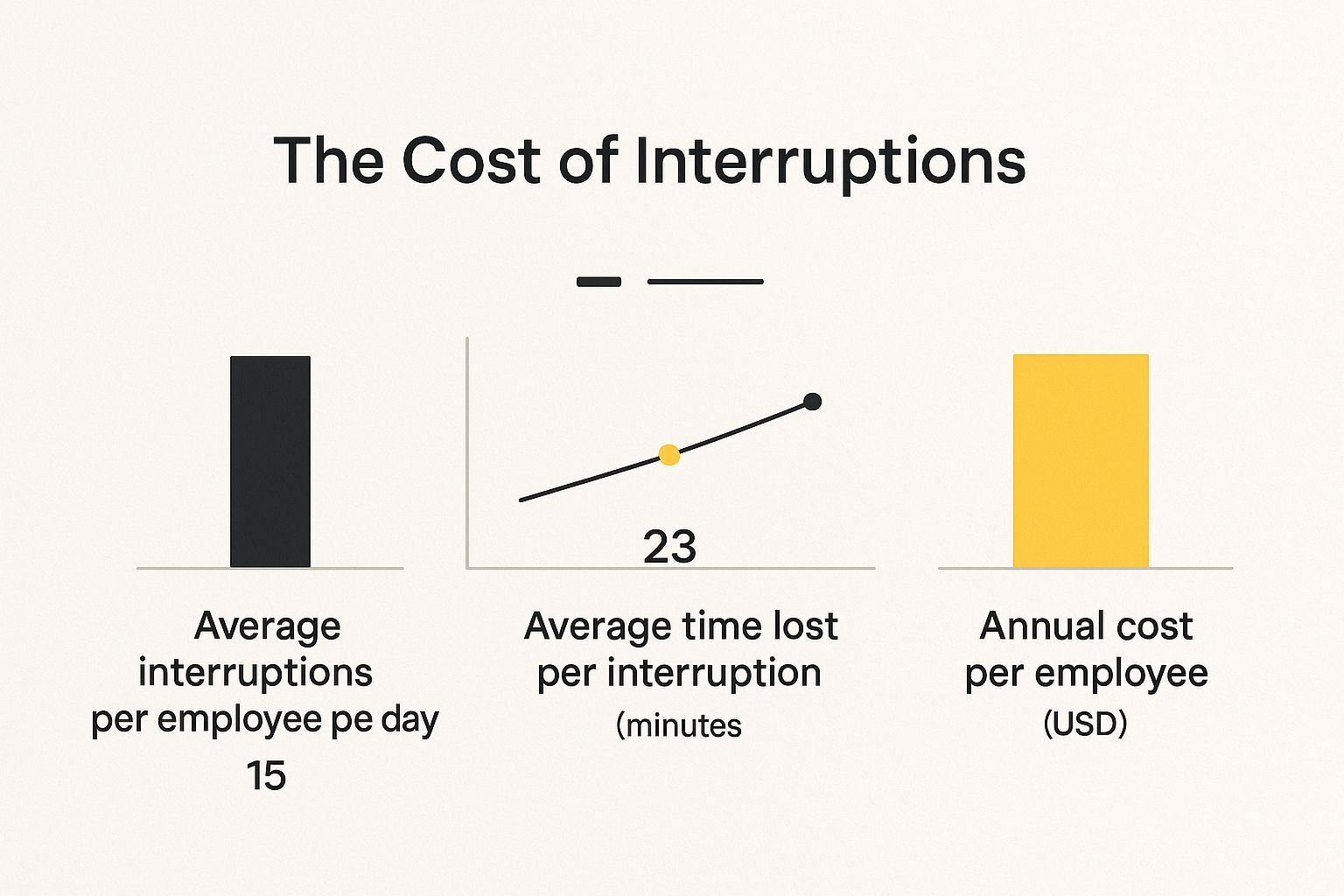The Shocking Price Tag of Workplace Interruptions
The typical Australian workplace buzzes with activity, but hidden within this daily hustle is a silent drain on productivity: interruptions. These seemingly small disruptions accumulate, significantly impacting time and resources. Just how much do these interruptions cost Australian businesses?
Australian workers lose an average of 600 hours annually due to workplace distractions. This puts Australia second globally, just behind France, with a loss of 608 hours. This substantial loss of focus stems from the ever-increasing demands of our hyper-connected work environments. Constant interruptions from colleagues, meetings, and messaging apps like Slack fracture our attention and decrease productivity.
These distractions have a real economic impact, costing businesses thousands of hours yearly in lost output and efficiency. The 600-hour figure represents a vast amount of potential productive time lost to these constant disruptions. Employees struggle to maintain focus on tasks in our digitally connected workplaces. These findings emphasize the need for strategies and policies designed to minimize distractions and boost overall workforce productivity in Australia. More detailed statistics can be found here: Australians lose 600 hours to workplace distractions.
Visualizing the Impact of Interruptions
The infographic below illustrates the daily impact of interruptions. It breaks down the average number of interruptions per employee, the time lost per interruption, and the staggering annual cost per employee.

As the infographic demonstrates, even small interruptions quickly add up to substantial costs, impacting both individual productivity and a company's bottom line. This highlights the critical need for effective interruption management strategies. To further combat distractions, consider implementing proven absence management strategies to minimize unexpected team gaps.
The True Cost Goes Beyond Lost Time
The financial implications are certainly alarming. However, the true cost of interruptions extends beyond just dollars and cents. Consider the flow state, that state of deep concentration where we are most productive. Each interruption shatters this flow, requiring significant time and effort to regain focus. This constant stop-and-start work pattern leads to several negative consequences:
-
Reduced Work Quality: Constant interruptions make employees more prone to errors, necessitating rework and revisions.
-
Increased Stress and Burnout: The never-ending barrage of disruptions contributes to employee stress, negatively impacting morale and increasing burnout rates.
-
Missed Deadlines: Interruptions disrupt workflow, making it difficult to meet deadlines and impacting project timelines.
This constant context switching also hinders creativity and problem-solving, impacting innovation and overall business performance. It's like trying to solve a complex puzzle while someone keeps rearranging the pieces.
Addressing the Interruption Epidemic
Understanding the true cost of interruptions is the first step toward reclaiming lost productivity. By implementing strategies to minimize distractions and cultivate a more focused work environment, Australian businesses can unlock significant gains in efficiency, innovation, and employee well-being. This isn't about eliminating communication entirely, but about creating a culture of mindful communication and respect for focused work time.
To better understand the financial impact across different regions, let's examine the following table:
The Annual Cost of Workplace Interruptions
A comparison of hours lost to workplace interruptions and their equivalent financial impact. This table uses hypothetical data for illustrative purposes.
| Country | Annual Hours Lost Per Employee | Estimated Cost Per Employee | Percentage of Work Year Lost |
|---|---|---|---|
| Australia | 600 | $15,000 | 27% |
| France | 608 | $15,200 | 28% |
| Germany | 550 | $13,750 | 25% |
| United Kingdom | 500 | $12,500 | 23% |
| United States | 450 | $11,250 | 20% |
As this table demonstrates, the cost of interruptions is significant across several developed nations. While the specific figures may vary, the overall trend highlights a substantial loss of productivity due to workplace disruptions. Addressing these interruptions is crucial for improving efficiency and maximizing output.
The Interruption Epidemic: What's Stealing Your Team's Focus

Not all interruptions are the same. Some are crucial for teamwork and finding solutions. However, many are silent productivity killers, steadily diminishing your team's focus and impacting your bottom line. This section explores the different types of interruptions affecting Australian workplaces—from the obvious to the subtle distractions you barely notice.
External vs. Internal Disruptions: A Two-Pronged Attack
Interruptions fall into two main categories: external and internal. External interruptions originate from outside sources, disrupting your workflow from the outside in. These are often simpler to identify and manage.
Think of unplanned meetings, a constant stream of chat notifications, or that friendly colleague who stops by for a "quick chat" that turns into a lengthy conversation. These are common complaints among Australian workers, particularly in open-plan offices.
Internal distractions, on the other hand, are self-generated interruptions originating from within. They are the internal thieves stealing our attention. This might look like task-switching, getting lost in digital rabbit holes, or simply experiencing attention fatigue.
These are often harder to manage because they stem from our own habits and behaviors.
Industry and Role-Specific Interruptions
Interruptions vary across industries and job roles. A tradesperson on a construction site experiences different interruptions than an office worker. A salesperson constantly interacting with clients will face different disruptions compared to a software developer needing deep focus.
For example, a real estate agent might be constantly interrupted by client calls, while a mortgage broker could struggle with managing emails and application updates. Understanding these role-specific interruptions is crucial for creating effective solutions.
To illustrate the varying impact of interruptions, let's examine a few examples:
| Interruption Type | Average Frequency | Recovery Time | Productivity Impact | Mitigation Difficulty |
|---|---|---|---|---|
| Client phone calls (Real Estate Agent) | High (10-20 per day) | Short (1-2 minutes) | Moderate | Low |
| Email/Application Updates (Mortgage Broker) | Medium (5-10 per day) | Medium (5-10 minutes) | Moderate | Medium |
| Unexpected Meetings (Office Worker) | Low (1-2 per day) | High (15-30 minutes) | High | High |
| Colleague Interruptions (Open Office) | High (5-15 per day) | Short (1-5 minutes) | Moderate to High | Medium |
This table highlights how frequency, recovery time, and the nature of the interruption contribute to its overall impact on productivity. It also suggests the relative difficulty of minimizing these disruptions.
The Hybrid Work Paradox: New Interruptions, New Challenges
The rise of hybrid work has presented a paradoxical situation. While it has eliminated some traditional office distractions (like constant colleague drop-ins), it has introduced new ones. Consider the constant pings of instant messaging, the blurring of work-life boundaries, and the difficulty of creating productive workspaces at home.
These new disruption patterns are still being explored and addressed by Australian organizations. For instance, while working from home may remove the distractions of a busy office, it can introduce new interruptions like family responsibilities or household chores. This highlights the need for adaptable and personalized strategies to manage interruptions in our changing work environments.
Beyond Lost Time: How Interruptions Damage Business Success

We've already seen how many interruptions Australian workers face and the different ways they show up. Now, let's explore the real cost of these constant disruptions. It goes far beyond just the immediate time lost, creating a ripple effect across the entire business.
The Domino Effect: From Interruptions to Declining Performance
Think about a complex project, carefully planned with each step building on the last. Suddenly, an interruption hits – an unexpected meeting or a flood of messages. The entire process can be derailed. It's not just the few minutes lost to the interruption itself. It's the time needed to refocus, rebuild momentum, and recapture that train of thought.
This can lead to a noticeable drop in work quality, more errors, and even missed opportunities. It’s like painstakingly building a house of cards, only to have it knocked down by a sudden breeze.
Constant distractions also impact our cognitive abilities. Research shows that cognitive performance, especially decision-making, suffers with each interruption. This can have serious consequences, particularly in roles demanding complex problem-solving and critical thinking. For example, a mortgage broker constantly interrupted might make calculation errors, or a real estate agent could overlook key details during a negotiation.
Furthermore, workforce interruptions and related inefficiencies, driven by current labor market conditions, are key factors in Australia's ongoing productivity struggles. Australian labor productivity, measured by GDP per hour worked, has stagnated for seven years. It's currently 5.7% below its pre-pandemic peak. This decline is partly due to disruptions like supply chain problems, workforce shortages, and shifts towards lower-productivity sectors. These manifest as delayed workflows, increased errors, and lower employee output. Learn more about these trends in the Indeed 2025 AU Jobs and Hiring Trends Report.
The Human Cost: Burnout, Dissatisfaction, and Turnover
The effects of constant interruptions are not just practical. Employees facing frequent disruptions report higher burnout, less job satisfaction, and a greater desire to leave their jobs. These are real costs for any business, affecting morale, team cohesion, and ultimately, the bottom line. It’s not just lost productivity, it's about losing valuable employees.
Interruption Cultures: A Systemic Threat to Innovation
Finally, let's consider the impact of "interruption cultures." These are workplaces where constant interruptions are not just accepted, but almost expected. They can undermine innovation and harm customer experiences in ways that don't always show up in standard productivity measures. Imagine a creative team brainstorming, constantly interrupted by requests for minor updates or approvals. The flow of ideas is broken, leading to less innovative results. Customer service suffers too, as interrupted interactions can frustrate customers and lower satisfaction. These hidden costs can severely impact a business’s long-term success.
The Understaffing Crisis: When Team Gaps Create Constant Chaos
In conversations with Australian business leaders, staff shortages consistently emerge as a key driver of costly workplace interruptions. When teams are understaffed, the remaining employees are pulled in countless directions, creating a chaotic atmosphere that makes focused work nearly impossible.
The Ripple Effect of Understaffing
Understaffing triggers a domino effect of interruptions. Existing team members must continually switch gears to fill responsibility gaps. This constant task-switching disrupts workflow and prevents deep work, the state where true productivity thrives. Imagine a small retail team during the holiday rush. If one person calls in sick, the others must juggle customer service, inventory management, and register operation, all while answering questions from stressed shoppers. This constant juggling act increases stress, reduces efficiency, and raises the likelihood of mistakes.
The Invisible Costs of Understaffing
These constant interruptions carry substantial hidden costs rarely captured by typical productivity metrics. These costs include higher error rates, compromised quality from rushed work, and the need for extensive revisions. Further, understaffing can delay or even cancel projects, leading to missed deadlines and lost business opportunities. These hidden costs accumulate, significantly impacting a company's bottom line.
Australian industry research underscores the impact of workforce shortages on operational efficiency. In 2025, 28% of businesses cited reduced operational efficiency due to staff shortages and resulting process gaps. Another 20% reported hindered growth. These interruptions and inefficiencies contribute to more errors, increased rework time, and heightened employee stress. Learn more about this in the Australian Industry Outlook 2025.
The Vicious Cycle of Burnout and Turnover
Perhaps the most detrimental consequence of understaffing is the vicious cycle it creates. Constant interruptions due to staff shortages lead to increased stress and burnout among existing employees. This, in turn, can drive higher turnover, exacerbating the initial staffing problem. Interruptions are linked to absences. Explore some practical absence management strategies to address this issue. This cycle is especially tough to break in sectors already grappling with workforce shortages, like healthcare.
Sector-Specific Challenges
Understaffing challenges vary across industries. In healthcare, it can jeopardize patient safety and lengthen wait times. In retail, it results in poor customer service and lost sales. In professional services, it can delay project completion and damage client relationships. In manufacturing, understaffing can negatively affect production output and product quality. Across all sectors, addressing the root causes of understaffing is crucial for minimizing interruptions and achieving sustainable productivity improvements.
Measuring What Matters: Your Interruption Audit Framework
You can't improve what you don't measure. Understanding the true cost of workplace interruptions requires a structured approach. We need to identify, categorize, and quantify these disruptions. This is where an interruption audit framework comes into play. Think of it like a financial audit, but instead of tracking money, you’re tracking attention.

Tracking Interruption Types: Know Your Enemy
The first step is identifying the types of interruptions affecting your team. This requires a detailed tracking system to categorize each disruption.
Are they primarily external interruptions? Think phone calls and meetings. Or are they internal distractions like procrastination and task-switching? Are certain communication tools contributing disproportionately to the disruption? Examples include Slack or email. Understanding the source allows you to target mitigation efforts more effectively.
Measuring Frequency and Recovery Time: Quantifying the Impact
Once you've identified the interruption types, measure their frequency and recovery time. How often do these interruptions occur? How long does it take employees to regain focus afterward?
Tools like time-tracking software and employee surveys can help gather this data. This information helps pinpoint the most disruptive interruptions and their cumulative effect on productivity. A five-minute interruption might seem minor. However, if it takes an employee 20 minutes to regain their flow state, the real cost is much higher.
The Financial Impact: Calculating the True Cost
Translating interruption data into its financial impact is key to getting management buy-in. This involves estimating the cost of lost productivity due to interruptions.
Calculate the lost time per interruption. Multiply it by the frequency. Then, apply an hourly rate. Now you can start to quantify the real cost in dollar terms. This information is crucial for demonstrating the return on investment of interruption management strategies. It also helps underscore the importance of addressing interruptions as a financial issue, not just an inconvenience.
Qualitative vs. Quantitative Data: Getting the Full Picture
A thorough interruption audit uses both qualitative and quantitative data. Quantitative data, like time-tracking logs and productivity metrics, provide measurable insights into frequency and duration.
Qualitative data from employee surveys and observational studies helps understand the impact of interruptions on employee well-being, morale, and work quality. Combining both types of data paints a comprehensive picture of the interruption landscape within your organization.
Benchmarking: Where Do You Stand?
Finally, compare your organization's interruption patterns against industry benchmarks. This provides valuable context. It helps you identify areas where your organization excels and where improvements are needed.
This data helps prioritize specific interruption-busting solutions and measure the success of your interventions. By identifying these key differences, you can distinguish between valuable collaboration and wasteful disruption.
Reclaiming Lost Productivity: Proven Interruption-Busting Strategies
The cost of interruptions at work is substantial, impacting both individual productivity and a company's bottom line. This section explores proven strategies to combat this pervasive issue, using real-world examples and expert insights.
Organizational Strategies: Fostering a Focus-Friendly Culture
Creating a culture that values focused work requires a proactive approach. "Deep work" blocks, where specific times are dedicated to uninterrupted individual work, have proven effective. For example, some organizations have adopted a "no meeting Wednesdays" policy, freeing up an entire day for focused project work.
Clear communication protocols are also vital. Designated "quiet zones" within the office can be highly beneficial. These zones require clear guidelines on when and how colleagues interact, ensuring collaborative efforts don't unintentionally disrupt focused work.
Physical Workspace Design: Architecture for Attention
The design of your physical workspace significantly impacts interruption frequency. Effective acoustic management, such as sound-absorbing materials and strategic placement of noisy equipment, minimizes auditory distractions.
Designated collaboration zones offer spaces for teamwork without impacting individual work areas. This allows discussions and brainstorming sessions to occur without disrupting colleagues needing quiet concentration. Additionally, architectural elements that promote individual privacy, like high-backed booths or enclosed offices, can create pockets of focus within a larger office.
Digital Workspace Management: Taming the Tech
Managing the digital workspace is equally important. Establishing clear notification protocols, limiting non-urgent alerts, and using features like "Do Not Disturb" can dramatically reduce digital distractions.
Prioritizing communication tools is key. Favor asynchronous methods like email for non-urgent matters and reserve instant messaging for immediate needs. For example, teams could agree to use Slack only for urgent issues and email for other updates. This reduces the urgency associated with each notification and promotes more thoughtful communication. Specialized technology solutions, such as OnSilent, can further minimize disruptions by intelligently managing calls and voicemails.
Individual Strategies: Mastering Self-Management
While organizational changes set the stage, individual strategies empower employees to manage interruptions effectively. Time-blocking, where specific time slots are allocated for different tasks, helps structure the day and minimize distractions.
Boundary-setting, communicating clear availability and expectations to colleagues, protects focused work time. Setting an out-of-office message during focused work periods signals unavailability and deters non-urgent interruptions. Cognitive methods like mindfulness techniques can also help employees re-enter a flow state more easily after unavoidable interruptions. This means quicker focus recovery after an interruption.
Measurable Results: Real-World Success Stories
Many companies have successfully transformed their interruption cultures. By implementing these combined strategies, organizations have reported significant improvements, such as a 20% increase in project completion rates and a 15% reduction in reported stress levels. These improvements demonstrate the tangible benefits of implementing comprehensive interruption management strategies. This positive impact on both individual well-being and overall organizational performance creates a ripple effect, improving morale and creating a healthier work environment.
Ready to take control of your communications and minimize distractions? Try OnSilent, the smart voicemail and call management solution designed to help you reclaim your focus and boost productivity. Learn more about OnSilent and start your free trial today!

